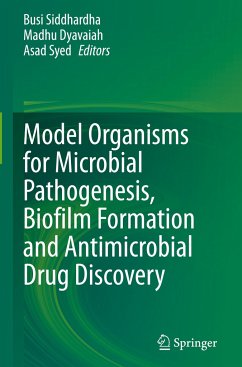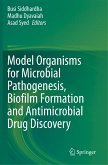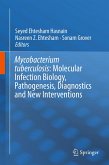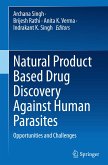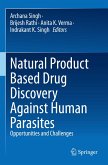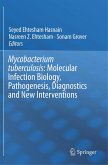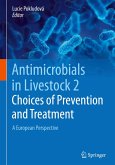Model Organisms for Microbial Pathogenesis, Biofilm Formation and Antimicrobial Drug Discovery
Herausgegeben:Siddhardha, Busi; Dyavaiah, Madhu; Syed, Asad
Model Organisms for Microbial Pathogenesis, Biofilm Formation and Antimicrobial Drug Discovery
Herausgegeben:Siddhardha, Busi; Dyavaiah, Madhu; Syed, Asad
- Gebundenes Buch
- Merkliste
- Auf die Merkliste
- Bewerten Bewerten
- Teilen
- Produkt teilen
- Produkterinnerung
- Produkterinnerung
This book provides essential insights into microbial pathogenesis, host-pathogen interactions, and the anti-microbial drug resistance of various human pathogens on the basis of various model organisms.
The initial sections of the book introduce readers to the mechanisms of microbial pathogenesis, host-pathogen interactions, anti-microbial drug resistance, and the dynamics of biofilm formation. Due to the emergence of various microbial resistant strains, it is especially important to understand the prognosis for microbial infections, disease progression profiles, and mechanisms of resistance…mehr
Andere Kunden interessierten sich auch für
![Model Organisms for Microbial Pathogenesis, Biofilm Formation and Antimicrobial Drug Discovery Model Organisms for Microbial Pathogenesis, Biofilm Formation and Antimicrobial Drug Discovery]() Model Organisms for Microbial Pathogenesis, Biofilm Formation and Antimicrobial Drug Discovery154,99 €
Model Organisms for Microbial Pathogenesis, Biofilm Formation and Antimicrobial Drug Discovery154,99 €![New Weapons to Control Bacterial Growth New Weapons to Control Bacterial Growth]() New Weapons to Control Bacterial Growth154,99 €
New Weapons to Control Bacterial Growth154,99 €![Mycobacterium Tuberculosis: Molecular Infection Biology, Pathogenesis, Diagnostics and New Interventions Mycobacterium Tuberculosis: Molecular Infection Biology, Pathogenesis, Diagnostics and New Interventions]() Mycobacterium Tuberculosis: Molecular Infection Biology, Pathogenesis, Diagnostics and New Interventions117,99 €
Mycobacterium Tuberculosis: Molecular Infection Biology, Pathogenesis, Diagnostics and New Interventions117,99 €![Natural Product Based Drug Discovery Against Human Parasites Natural Product Based Drug Discovery Against Human Parasites]() Natural Product Based Drug Discovery Against Human Parasites193,99 €
Natural Product Based Drug Discovery Against Human Parasites193,99 €![Natural Product Based Drug Discovery Against Human Parasites Natural Product Based Drug Discovery Against Human Parasites]() Natural Product Based Drug Discovery Against Human Parasites193,99 €
Natural Product Based Drug Discovery Against Human Parasites193,99 €![Mycobacterium Tuberculosis: Molecular Infection Biology, Pathogenesis, Diagnostics and New Interventions Mycobacterium Tuberculosis: Molecular Infection Biology, Pathogenesis, Diagnostics and New Interventions]() Mycobacterium Tuberculosis: Molecular Infection Biology, Pathogenesis, Diagnostics and New Interventions116,99 €
Mycobacterium Tuberculosis: Molecular Infection Biology, Pathogenesis, Diagnostics and New Interventions116,99 €![Antimicrobials in Livestock 2: Choices of Prevention and Treatment Antimicrobials in Livestock 2: Choices of Prevention and Treatment]() Antimicrobials in Livestock 2: Choices of Prevention and Treatment178,99 €
Antimicrobials in Livestock 2: Choices of Prevention and Treatment178,99 €-
-
-
This book provides essential insights into microbial pathogenesis, host-pathogen interactions, and the anti-microbial drug resistance of various human pathogens on the basis of various model organisms.
The initial sections of the book introduce readers to the mechanisms of microbial pathogenesis, host-pathogen interactions, anti-microbial drug resistance, and the dynamics of biofilm formation. Due to the emergence of various microbial resistant strains, it is especially important to understand the prognosis for microbial infections, disease progression profiles, and mechanisms of resistance to antibiotic therapy in order to develop novel therapeutic strategies.
In turn, the second part of the book presents a comparative analysis of various animal models to help readers understand microbial pathogenesis, host-pathogen interactions, anti-microbial drug discovery, anti-biofilm therapeutics, and treatment regimes. Given its scope, the book represents a valuable asset formicrobiologists, biotechnologists, medical professionals, drug development researchers, and pharmacologists alike.
The initial sections of the book introduce readers to the mechanisms of microbial pathogenesis, host-pathogen interactions, anti-microbial drug resistance, and the dynamics of biofilm formation. Due to the emergence of various microbial resistant strains, it is especially important to understand the prognosis for microbial infections, disease progression profiles, and mechanisms of resistance to antibiotic therapy in order to develop novel therapeutic strategies.
In turn, the second part of the book presents a comparative analysis of various animal models to help readers understand microbial pathogenesis, host-pathogen interactions, anti-microbial drug discovery, anti-biofilm therapeutics, and treatment regimes. Given its scope, the book represents a valuable asset formicrobiologists, biotechnologists, medical professionals, drug development researchers, and pharmacologists alike.
Produktdetails
- Produktdetails
- Verlag: Springer / Springer Nature Singapore / Springer, Berlin
- Artikelnr. des Verlages: 978-981-15-1694-8
- 1st edition 2020
- Seitenzahl: 704
- Erscheinungstermin: 29. März 2020
- Englisch
- Abmessung: 241mm x 160mm x 41mm
- Gewicht: 1282g
- ISBN-13: 9789811516948
- ISBN-10: 9811516944
- Artikelnr.: 58078119
- Herstellerkennzeichnung Die Herstellerinformationen sind derzeit nicht verfügbar.
- Verlag: Springer / Springer Nature Singapore / Springer, Berlin
- Artikelnr. des Verlages: 978-981-15-1694-8
- 1st edition 2020
- Seitenzahl: 704
- Erscheinungstermin: 29. März 2020
- Englisch
- Abmessung: 241mm x 160mm x 41mm
- Gewicht: 1282g
- ISBN-13: 9789811516948
- ISBN-10: 9811516944
- Artikelnr.: 58078119
- Herstellerkennzeichnung Die Herstellerinformationen sind derzeit nicht verfügbar.
Dr. Busi Siddhardha is an Assistant Professor at the Department of Microbiology, Pondicherry University, India. He received his Ph.D. from the Biology Division, CSIR-IICT, Hyderabad. He has worked extensively in the field of nanotechnology, and on the applications of nanotechnology in drug discovery, drug delivery, sustained release and photodynamic therapy. His current research focuses on bacterial quorum sensing, biofilms, antimicrobial photodynamic therapy and nanobiotechnology. He serves on the editorial boards of various respected journals, has published more than 60 research articles in peer-reviewed international journals, and has authored or co-authored numerous book chapters. He is a member of several national and international scientific societies. Dr. Madhu Dyavaiah is an Assistant Professor at the Department of Biochemistry and Molecular Biology, Pondicherry University, India. He has previously served as a Research Scientist at the College of Nanoscale Science and Engineering, Albany, USA (2010-2012), Postdoctoral Associate at Gen'NY'sis Center for Excellence in Cancer Genomics, Rensselaer, USA (2006-2010), and Postdoctoral Fellow at the Wadsworth Center, New York Dept. of Health, USA (2003-2006). His research interests include molecular pathogenesis, DNA damage response, tRNA modification and translation regulation, and the biology of aging. Currently, he is working with different model systems such as S. cerevisiae and mice models to study the effects of natural compounds on microbial pathogens, neurodegenerative diseases and cancer. He has received various prestigious awards and is a member of many scientific societies and organizations. He has served as a reviewer for a number of international journals, published more than 20 research articles in peer-reviewed international journals, and authored three book chapters. Dr. Asad Syed is an Assistant Professor at the Botany and Microbiology Department, College of Science, King Saud University, Riyadh, Saudi Arabia. He completed his Ph.D. at the University of Pune, India, and subsequently worked at CSIR National Chemical Laboratory in Pune, where he served as a Research Associate and Senior Research Fellow in the Biochemical Sciences Division. His research interests are in the fabrication of nanomaterials utilizing microorganisms including fungi, bacteria, and plant extracts. He is currently serving as a reviewer for a number of international journals and has published his research in various peer-reviewed international journals on materials science and microbiology.
Chapter 1. Microbial infections and virulence factors.- Chapter 2. Microbial Pathogenesis: Virus pathogen-host interactions.- Chapter 3. A physical insight of biofilms.- Chapter 4. A Review on Microbial Pathogenesis and Host Response.- Chapter 5. Role of quorum sensing in microbial infections and biofilm formation.- Chapter 6. Microbial Pathogenesis and Antimicrobial Drug Resistance.- Chapter 7. Pathogenesis and antibiotic resistance of Staphylococcus aureus.- Chapter 8. Pathogenesis, Virulence factors and Antibiotic resistance of Group B Streptococcus.- Chapter 9. Enterococcal infections and Drug resistance mechanisms.- Chapter 10. Pathogenic Escherichia coli: Virulence factors and their Antimicrobial resistance.- Chapter 11. Enterobacter Infections and antimicrobial drug resistance.- Chapter 12. Klebsiella pneumoniae infections and antimicrobial drug resistance.- Chapter 13. Pathogenesis and drug resistance of Pseudomonas aeruginosa.- Chapter 14. Acinetobacter baumannii: Infections and drug resistance.- Chapter 15. Vibrio cholera: Mechanisms of Pathogenicity and Antibiotic resistance.- Chapter 16. Current trends in Mycobacterium tuberculosis pathogenesis and drug resistance.- Chapter 17. PATHOGENESIS OF FUNGAL INFECTIONS AND DRUG- RESISTANCE PHENOMENON.- Chapter 18. Pathogenesis and drug resistance profile of food-borne pathogens.- Chapter 19. Cell lines as in vitro model for studying microbial pathogenesis.- Chapter 20. Animal models to understand host-pathogen interactions.- Chapter 21. Caenorhabditis elegans as pathogenesis model to understand bacterial virulence.- Chapter 22. Zebra fish infection model: From pathogenesis to therapeutics.- Chapter 23. Mycobacterium pathogenesis and drug discovery: Looking through the zebra fish keyhole.- Chapter 24. Murine models to study acute and chronic bacterial infections.- Chapter 25. Non-human primate model use in understanding infectious diseases.- Chapter 26. Understanding Biofilm Dynamics: In Vitro and In Vivo Models.- Chapter 27. Model organisms and antimicrobial drug discovery.- Chapter 28. Yeast: A model organism for antimicrobial drug discovery.- Chapter 29. Caenorhabditis elegans: A tool for antimicrobial drug discovery.- Chapter 30. Zebrafish Model System in Antimicrobial Drug Discovery.- Chapter 31. Murine Models for Development of Anti-Infective Therapeutics.- Chapter 32. Non-human primate models for antimicrobial drug discovery.
Chapter 1. Microbial infections and virulence factors.- Chapter 2. Microbial Pathogenesis: Virus pathogen-host interactions.- Chapter 3. A physical insight of biofilms.- Chapter 4. A Review on Microbial Pathogenesis and Host Response.- Chapter 5. Role of quorum sensing in microbial infections and biofilm formation.- Chapter 6. Microbial Pathogenesis and Antimicrobial Drug Resistance.- Chapter 7. Pathogenesis and antibiotic resistance of Staphylococcus aureus.- Chapter 8. Pathogenesis, Virulence factors and Antibiotic resistance of Group B Streptococcus.- Chapter 9. Enterococcal infections and Drug resistance mechanisms.- Chapter 10. Pathogenic Escherichia coli: Virulence factors and their Antimicrobial resistance.- Chapter 11. Enterobacter Infections and antimicrobial drug resistance.- Chapter 12. Klebsiella pneumoniae infections and antimicrobial drug resistance.- Chapter 13. Pathogenesis and drug resistance of Pseudomonas aeruginosa.- Chapter 14. Acinetobacter baumannii: Infections and drug resistance.- Chapter 15. Vibrio cholera: Mechanisms of Pathogenicity and Antibiotic resistance.- Chapter 16. Current trends in Mycobacterium tuberculosis pathogenesis and drug resistance.- Chapter 17. PATHOGENESIS OF FUNGAL INFECTIONS AND DRUG- RESISTANCE PHENOMENON.- Chapter 18. Pathogenesis and drug resistance profile of food-borne pathogens.- Chapter 19. Cell lines as in vitro model for studying microbial pathogenesis.- Chapter 20. Animal models to understand host-pathogen interactions.- Chapter 21. Caenorhabditis elegans as pathogenesis model to understand bacterial virulence.- Chapter 22. Zebra fish infection model: From pathogenesis to therapeutics.- Chapter 23. Mycobacterium pathogenesis and drug discovery: Looking through the zebra fish keyhole.- Chapter 24. Murine models to study acute and chronic bacterial infections.- Chapter 25. Non-human primate model use in understanding infectious diseases.- Chapter 26. Understanding Biofilm Dynamics: In Vitro and In Vivo Models.- Chapter 27. Model organisms and antimicrobial drug discovery.- Chapter 28. Yeast: A model organism for antimicrobial drug discovery.- Chapter 29. Caenorhabditis elegans: A tool for antimicrobial drug discovery.- Chapter 30. Zebrafish Model System in Antimicrobial Drug Discovery.- Chapter 31. Murine Models for Development of Anti-Infective Therapeutics.- Chapter 32. Non-human primate models for antimicrobial drug discovery.

